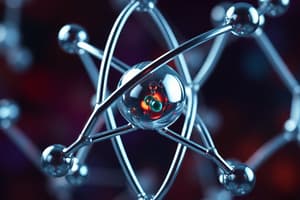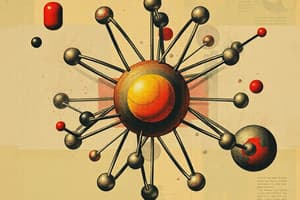Podcast
Questions and Answers
Which bond is said to be the 'bond of life' and is crucial in the structure of DNA?
Which bond is said to be the 'bond of life' and is crucial in the structure of DNA?
- Ionic bond
- Metallic bond
- Hydrogen bond (correct)
- Covalent bond
What type of bond is primarily formed between aluminum and chlorine in aluminum chloride?
What type of bond is primarily formed between aluminum and chlorine in aluminum chloride?
- Van der Waals force
- Ionic bond
- Coordinate covalent bond (correct)
- Hydrogen bond
How many electrons does aluminum need to achieve a full valence shell?
How many electrons does aluminum need to achieve a full valence shell?
- Four
- Three
- One
- Two (correct)
In the formation of carbon monoxide (CO), how many electrons does oxygen share with carbon?
In the formation of carbon monoxide (CO), how many electrons does oxygen share with carbon?
What role do hydrogen bonds play in proteins?
What role do hydrogen bonds play in proteins?
What type of hydrogen bonds help form insoluble proteins?
What type of hydrogen bonds help form insoluble proteins?
Which property is provided to plants through hydrogen bonding in cellulose?
Which property is provided to plants through hydrogen bonding in cellulose?
What is a characteristic of fibrous proteins due to their hydrogen bonding?
What is a characteristic of fibrous proteins due to their hydrogen bonding?
In drug-receptor binding, what role do hydrogen bonds play?
In drug-receptor binding, what role do hydrogen bonds play?
Which molecule is described as a covalent dimer with the formula Al2Cl6?
Which molecule is described as a covalent dimer with the formula Al2Cl6?
Flashcards are hidden until you start studying
Study Notes
Introduction to Chemical Bonding
- Fundamental concept in chemistry explaining atom attraction and product formation.
- Atoms consist of a nucleus (protons and neutrons) with electrons in different energy levels.
- Electrons in the outermost energy level, also known as valence electrons, play a key role in bonding.
Chemical Bonding
- Bonds are attractive forces linking neighboring atoms in molecules or compounds.
- Atoms bond to achieve a stable electronic configuration, typically resembling that of noble gases.
- Most noble gases have eight electrons in their outer shell, while helium has two.
- Core electrons, located in filled energy shells, do not participate in bonding, only valence electrons do.
Lewis Electron Dot Diagram
- A model used to represent an atom's valence electrons.
- The element's symbol is surrounded by dots representing its valence electrons.
- Provides insights on bonding and the number of electron pairs involved.
- Atom attempts to fill its outer shell to achieve a stable octet (eight electrons) or for hydrogen and helium, a duet (two electrons).
- Valence electron count determines the number needed to complete the octet.
Bond Types
- Polar Covalent Bonds: Occur when electrons are shared unequally, leading to partial positive (δ+) and negative (δ-) charges.
- Examples include water (H2O) and hydrogen fluoride (HF).
- Nonpolar Covalent Bonds: Form when two atoms share electrons equally, often with similar electronegativities (e.g., H2, O2).
- Ionic Bonds: Occur when the electronegativity difference is 2.0 or greater, resulting in the transfer of electrons.
Bond Polarity and Intermolecular Forces
- Bond polarity describes the unequal sharing of electrons between mixed electronegativities.
- Polar molecules exhibit dipole moments and can interact through induced dipole forces, such as van der Waals forces, which are weak.
- Alkanes, having similar electronegativities, are nonpolar with significant van der Waals interactions depending on molecular contact area.
Hydrogen Bonding
- A strong attractive force between hydrogen bound to electronegative atoms and other electronegative atoms.
- Critical in polar molecules (e.g., water), impacting properties like surface tension and viscosity.
- Hydrogen bonds are represented by dashed lines, distinguishing them from covalent bonds.
Examples of Bonding
- Aluminum Chloride (Al2Cl6): Covalent bonding between aluminum and chlorine; aluminum forms coordinate covalent bonds due to electron deficit.
- Carbon Monoxide (CO): Carbon and oxygen share electrons to satisfy octets, including a double bond and a coordinate covalent bond.
Importance in Pharmacy and Medicine
- Hydrogen bonding is essential for biological structures.
- Responsible for the double helix structure of DNA and protein folding.
- Influences properties of proteins based on intramolecular and intermolecular hydrogen bonds.
- Cellulose rigidity arises from hydrogen bonding in polysaccharides.
- Plays a crucial role in drug-receptor interactions in pharmacology, aiding in the binding process at the molecular level.
Studying That Suits You
Use AI to generate personalized quizzes and flashcards to suit your learning preferences.




